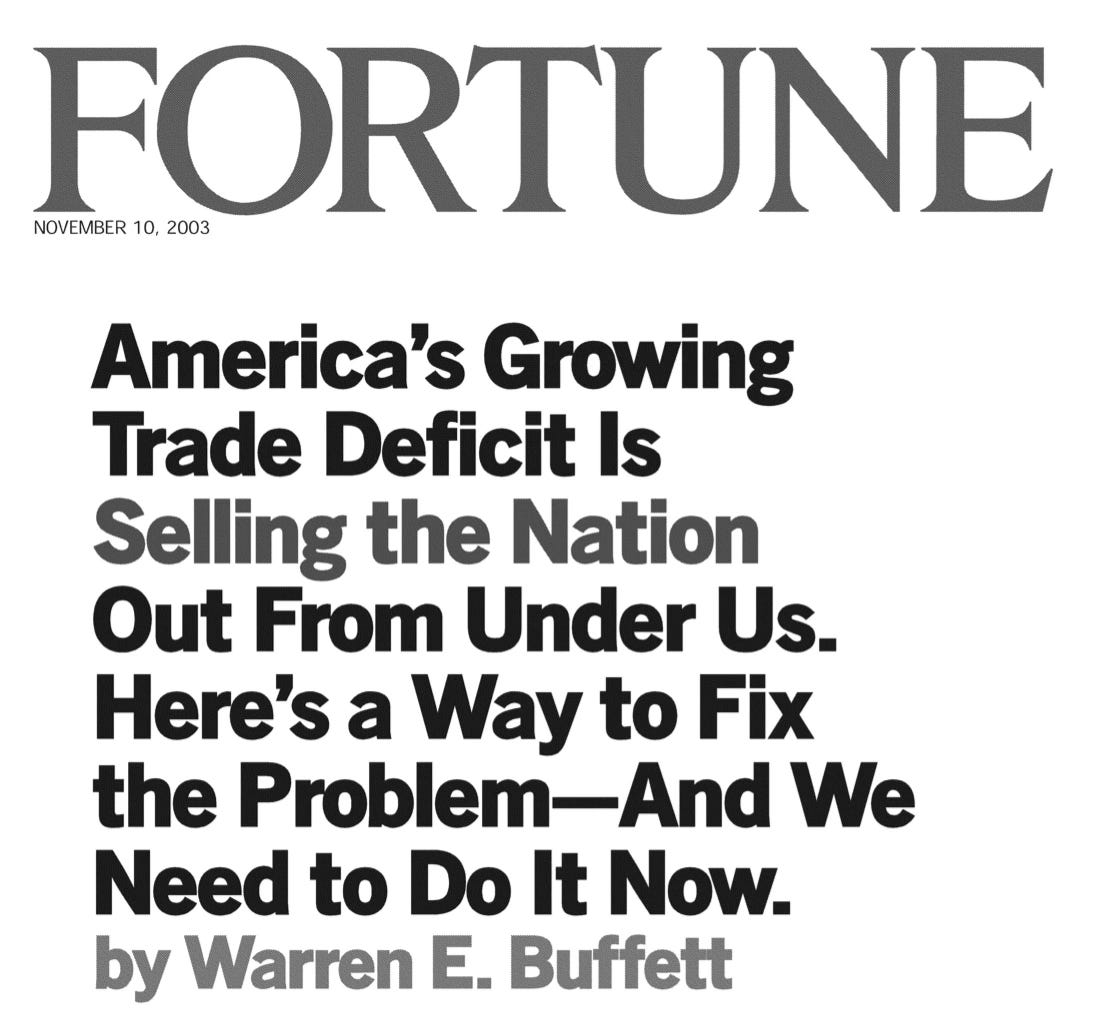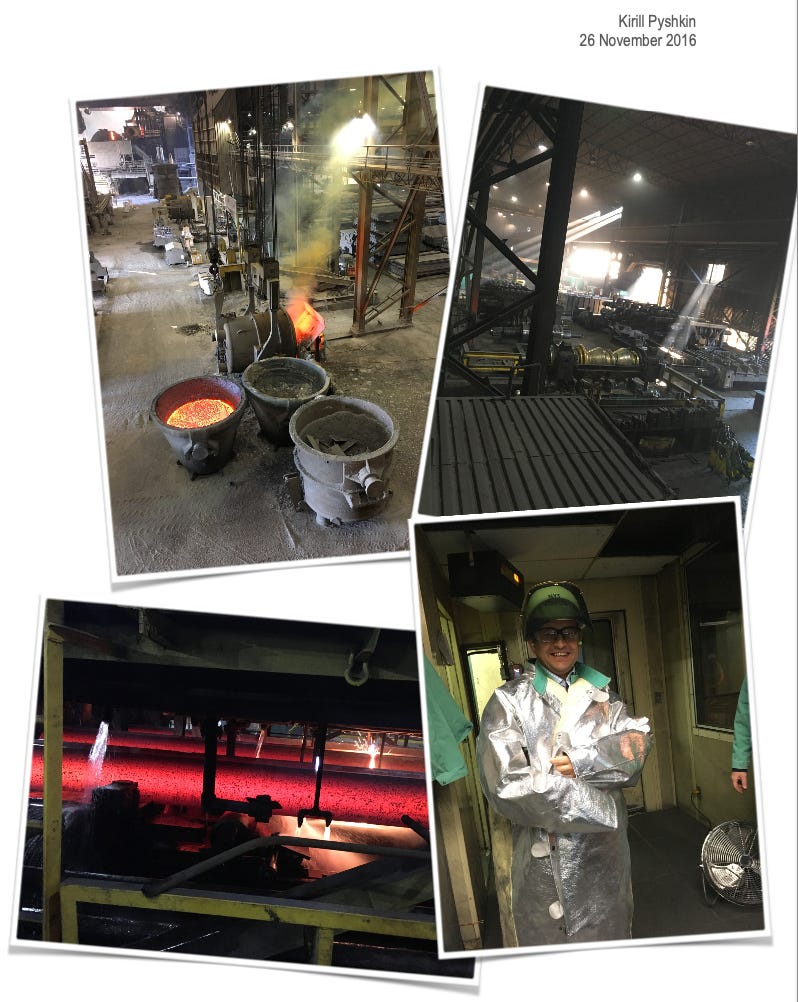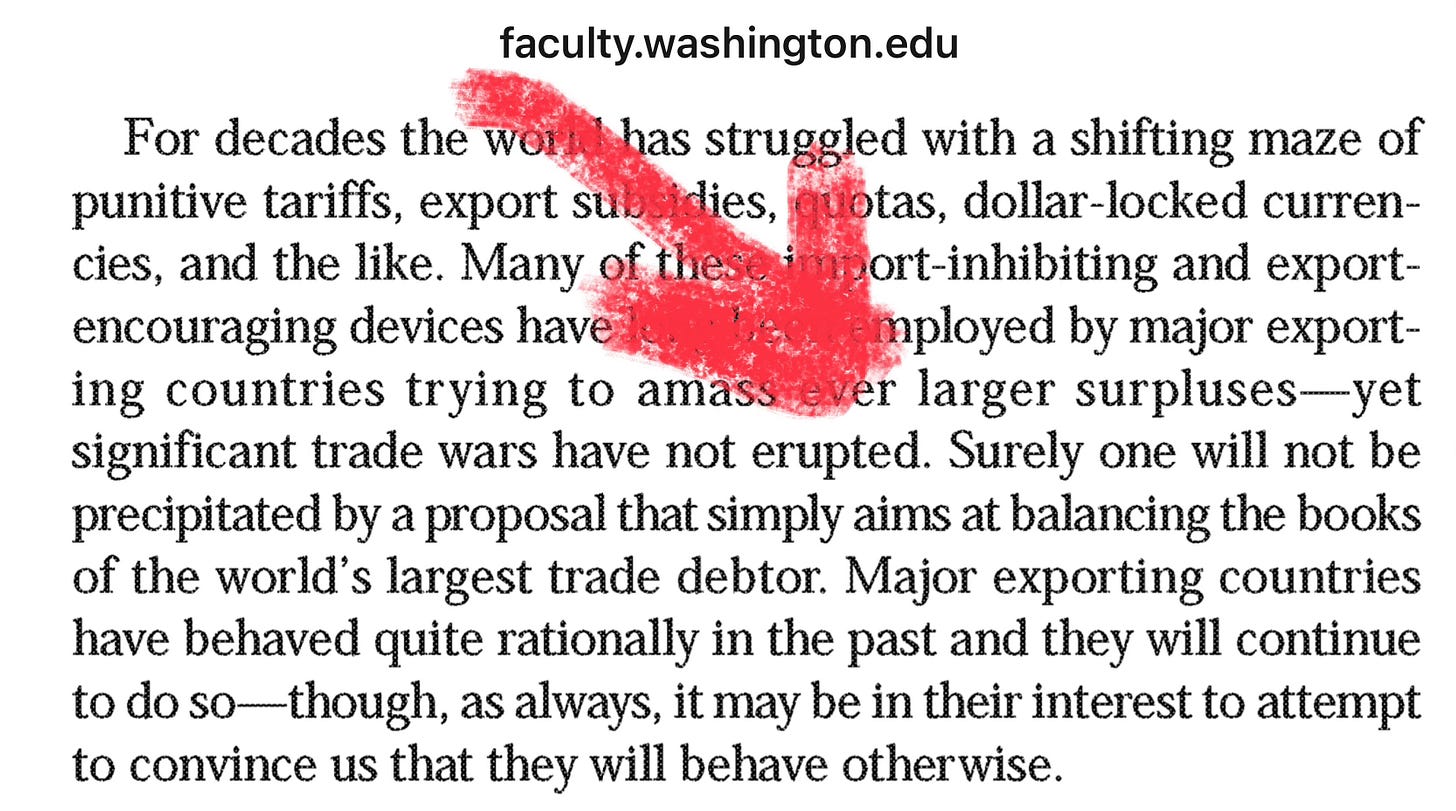Why do penguins need an F-16?
(and why "tariff" is the most beautiful word in the dictionary)
The answer to the most pressing question why penguins need an F-16 is revealed at the very end of this article, but for now let me explain the context…
Trump’s “reciprocal tariffs”
Calling the measures announced earlier this week “reciprocal tariffs”may have been a little disingenuous. It would have been honest to just call them economic sanctions on countries with a trade surplus with the US. But we all know that “tariff” is the most beautiful word in the English dictionary.
On a serious note, how would you address the issue of trade deficit, if that was your election promise, when goods traded are completely different on each side? And first of all, why is Trump so keen on addressing the trade deficit?
Why is the US trade deficit a problem?
I read a good explanation in this 20 year old article in Fortune. There, Warren Buffett vividly illustrates how a persistent trade deficit gradually transfers national wealth abroad on an example of two islands Thriftville and Squanderville. So already in 2003 when the US national debt was approaching $7trln, Warren Buffet was warning that the situation is unsustainable. Since then the US national debt increased over five fold to exceed $36trln as of today.
Source: https://faculty.washington.edu/ss1110/IF/Buffett%20Fortune%202003%20(6).pdf
Trump is clearly determined to tackle the US budget deficit, to which interest paid on debt is a key contributor. The Administration’s other efforts to tackle the deficit are focused on the reduction of Government expenditure (Elon Musk’s DOGE fiefdom - you can track his efforts in real time on the departmental website); plus the publicly stated desire to lower yield on US bonds, hence the well publicised pressure on the Fed to lower rates, and the desire to weaken the US dollar. Trump is therefore consistent in his policy efforts, although some of the actions may backfire.
Creating manufacturing jobs was the election promise
Cutting the budget deficit is not an election winner. However, the issue that resonates well with the electorate is jobs. Even though the US overall has become one of the wealthiest countries through globalisation, there are many regions that are suffering. I remember my work trips in the Rust Belt or the southern states of Georgia, Tennessee and Arkansas. It is very different from New York and Boston.
Here is an extract from my trip notes from meeting steel workers at Nucor Arkansas plant during Trump’s first term:
“The experience and training required for mixing the right blend of alloy at a precise temperature is similar to that of a head chef at a Michelin-star restaurant. One small difference is that the cooking temperature is somewhat higher at 1800 degrees. Oh yes, and you work 4 days in a row, on 12-hour shifts, and sometimes you have to stand within 1m of a steel melting pot.
[name removed], has 14 years of experience out of which the last 2 he spent at this post. Every once in a while he gets out of his booth to take a manual sample of molten steel with a mass spectrometer also operated by him. With 14 years at the factory [name removed] is one of the newer employees. I met three others, two of them have worked for Nucor for 22 years and the third one for 41 years. At 67 years of age he is not thinking of retiring and the company is more than happy to retain him with the incredible wealth of experience he has accumulated.
Not surprisingly there was consensus around the table in agreement with the [Trump’s] policies to prevent American jobs going to Mexico and China. In fact, the former CEO of Nucor is Trump’s economic advisor. Another big cheer was for his infrastructure plans, they say they could do with better roads, schools and airports.
Nucor is the largest maker of infrastructure steel in the US and they had real pride in telling me that it is their steel that supplies the new World Trade Centre in New York; while being happy that Nucor has recently won a couple of trade disputes that will restrict imports of certain types of Chinese steel.”
That’s me in the bottom right corner:
Photo credit: Kirill Pyshkin, 2016
Ricardo’s economic theory of Comparative Advantage tells us that countries should specialise to maximise opportunity costs. This theory tells us that the way to even more prosperity for the US lies through creating more value added jobs such as those in industrial design, services or AI.
However, many parts of the US are not particularly suited for such activities, at least at the moment, and have a proud history of manufacturing. While manufacturing does not need to be low skilled - read my trip notes above - some manufacturing jobs, for example, those which will be required at the TSMC new semiconductor fab in Arizona are likely to be so skilled, that the US may actually struggle to find the talent.
Many of these regions also happen to be the key election battle states. You can read the first hand reaction to the announced tariffs from people in those states in this BBC article.
Source: BBC, https://www.bbc.co.uk/news/articles/cr4nr3230e7o
Now let me explain how exactly these “tariffs” could bring jobs back to the US.
Why “tariff” is the most beautiful word in the dictionary
As I said already, these “tariffs” are not tariffs at all. Rather, they are an invitation to a negotiating table on a range of issues, which are not necessarily economic. Now we are venturing into the field of geoeconomics.
For example, Gillian Tett in her FT article attempts to make sense of things. She mentions a paper from a trio of American economists — Christopher Clayton, Matteo Maggiori and Jesse Schreger — released just after Trump spoke in the Rose garden, outlining the growing field of “geoeconomics”, inspired by Albert Hirschman, author of a book published in 1945, National Power and the Structure of Foreign Trade.
The idea is that we are always operating at the intersection of geopolitics and economic interests. Therefore, for example, one could link the issue of Greenland to the “tariffs” imposed on the EU. Similarly, the punitive 34% tariff on China could perhaps be removed during the forthcoming state visit of President Xi to the US, as “a gesture of goodwill” and as part of a new bilateral geopolitical deal announcement.
Why do Penguins need an F-16?
Now I am getting to the core question of this article.
So far countries have been “invited” by the US to the negotiating table in strong terms. These negotiations can cover a whole range of seemingly unrelated issues.
Moreover, the initial set of conditions is designed to put the US in a stronger negotiating position because the “tariffs” are calculated as simply half the trade deficit.
By definition, the other side will suffer more than the US from imposing a mirror tariff.
This is an important point to understand as it brings a strong incentive for a“deal”.
Furthermore, I think it would be foolish for a country to retaliate and many would agree. Read this quote from Warren Buffet’s article mentioned above:
In my opinion, most smaller countries would fold immediately, for example, like Israel which has already eliminated its remaining tariffs against US goods; larger ones, like China or the EU, would strike a deal after initial posturing, because the strong incentives are there (see above). This deal may be part of a larger agreement of a range of issues from Greenland to the Arctic.
The Penguin’s negotiating strategy
Now back to penguins. If you are a small country - what could your negotiating strategy with the US be? (For those who don’t know, I keep talking about penguins because of the much ridiculed imposed tariffs on Heard and McDonald Islands - two tiny, remote Antarctic outposts populated by penguins and seals - perhaps, because they are the Thriftville and Squanderville islands in the Warren Buffets article?)
Option A.
Drop your tariffs on all US goods to zero and beg the US to be kind to penguins and seals, while lobbying through the residents of San Diego Zoo.
Option B.
If you already have zero or minimal tariffs on US goods, offer to buy more US goods of large value, for example consider an F-16. That would skew your trade balance the other way, automatically correcting the “tariff” calculation. If you don’t have any money at all, have you looked underground for rare earth minerals? If none found, perhaps offer your land for a US air base.
Option C.
Open a massive penguin egg factory in the US to further drive the price of eggs down. Get your inspiration from TSMC of Taiwan.
Note, that all the “joke” options listed options above, nevertheless bring jobs to the US.
Option A. Zero tariffs = more exports, fewer trade barriers for US goods.
Option B. Purchase more US goods = more US exports, more concessions.
Option C. Foreign direct investments = directly creating more US jobs.
Aren’t tariffs inflationary?
Most economists agree that these “tariffs” are inflationary and as such represent a big tax on US consumers. Yes, absolutely, prices will go up in the short term but the economy will adjust eventually. For me, creating jobs outweighs inflation. Look at Switzerland - prices (and salaries) are eye-watering high but the country continues to attract people by its extremely high standard of living.
Would you rather be unemployed and shopping for discount deals at Walmart, or be in a highly skilled manufacturing job at TSMC Arizona fab and complaining about the extra $25k that you have to pay on your latest $100k Mercedes AMG convertible? Then you have several options - do you really need those 19’ alloys wheels, or perhaps just chose a classic red Mustang? My point is that having a job is more important.
Investment conclusion
We were a single voice immediately shouting about the overvaluation of US equities when we published our investment outlook for 2025 last November.
Then we argued that the US equities will take a breather and better returns may be available elsewhere. We suggested equal allocation to equities and bonds but with a preference for Europe over the US. We were concerned about US inflation, and proposed gold, CHF and Bitcoin as a hedge. We were cautious on other commodities because we expected that the two active geopolitical conflicts would be settled quickly under Trump. Finally, we predicted that a settlement in Ukraine would act as a catalyst for European assets.
We have arranged our multi-asset portfolio accordingly and recently reported that despite the turmoil in the equity markets this portfolio showed resilience and positive return over the first quarter 2025 of 4.2% in USD. I hope I got your attention here.
Now we think that these “tariffs” or whatever you call them, are very positive for the US over the long term because they may eventually lower trade barriers for US goods, attract foreign direct investments and stimulate its local manufacturing. This is why now we are incrementally more positive on the prospects for all US assets.
We are not ready to make the big allocation call just yet because of the volatility in the markets but we are watching carefully and making incremental changes to our portfolios.
Contact me directly for more information.
Now for the most the exciting part, to answer the key question in the title …
…drum-rolls…
…Penguins need an F-16 to defend themselves against seals, D’oh!
Source: https://demonflyingfox.com/
Disclosure
My articles represent my personal opinions and are provided for information purposes only. Their content is not intended to be an investment advice, or a personal recommendation to buy or sell any financial instrument or product, or to adopt any investment strategy as it is not provided based on an assessment of your investing knowledge and experience, your financial situation or your investment objectives. I use information sources which I believe to be reliable, but their accuracy cannot be guaranteed. The value of your investments, and the income derived from them, may go down as well as up. You may not get back all the money that you invest. The investments referred to in this article may not be suitable for all investors and, if in doubt, an investor should seek advice from a qualified investment advisor.







A brilliant new Penguin war anthem has appeared since the publication of this article. Now they are not just armed with the best US military equipment money can buy but also morally ready to fight! https://youtu.be/HJ8qGOe2K0o?si=PDafBxvjdAbArCPi
In this article on Apr.6 I predicted that US will be asking countries to buy their F-16s to “correct” the trade balance.
My only mistake was that it is F-35s that they are pushing.
This is exactly what JDVance suggested on his trip to India: https://timesofindia.indiatimes.com/india/jd-vance-pushes-f-35s-to-help-iaf-secure-indias-airspace/articleshow/120534368.cms